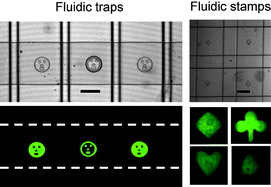Microfluidic valves with integrated structured elastomeric membranes for reversible fluidic entrapment and in situchannel functionalization
Abstract
We report the utility of structured elastomeric membranes (SEMs) as a multifunctional microfluidic tool. These structured membranes are part of a two-layer microfluidic device, analogous to membrane valves, with the novelty that they incorporate topographical features on the roof of the fluid channel. We demonstrate that when the topographical features are recessed into the roof of the fluid channel, actuation of the membrane leads to effective confinement of fluids down to femtolitres in preformed microfluidic containers. Thus, the SEMs in this case function as fluidic traps that could be coupled to microfluidic networks for rapid and repeated flushing of


 Please wait while we load your content...
Please wait while we load your content...